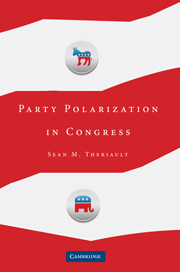2 - A Brief History of Party Polarization
Published online by Cambridge University Press: 05 September 2012
Summary
Horrible images of plane crashes, collapsed buildings, and panic throughout New York and Washington, D.C., dominated the airwaves on September 11, 2001. As the president was shuffled from secure location to secure location, members of Congress attempted to restore calm and stability to the American government. On the evening of the attacks, more than 150 legislators – both Democrats and Republicans from both the House and the Senate – gathered on the steps of the U.S. Capitol to declare their solidarity. Speaker Dennis Hastert thundered, “When America suffers, and when people perpetrate acts against this country, we as a Congress and a government stand united and we stand together to fight this evil threat.” After a moment of silence, the legislators broke into a spontaneous a capella rendition of “God Bless America.”
A day later, Senate Majority Leader Tom Daschle, a Democrat, articulated the same message on the Senate floor: “The world should know that the members of both parties, in both houses, stand united.” Hastert's and Daschle's actions followed their rhetoric: within a week, both chambers of Congress passed a Use of Force Resolution giving the president wide latitude to retaliate against the perpetrators of the September 11 attacks and a $40 billion emergency appropriation to help the affected areas. Both pieces of legislation passed unanimously in both chambers but for Congresswoman Barbara Lee's lone dissenting vote on the Use of Force Resolution.
- Type
- Chapter
- Information
- Party Polarization in Congress , pp. 13 - 42Publisher: Cambridge University PressPrint publication year: 2008



